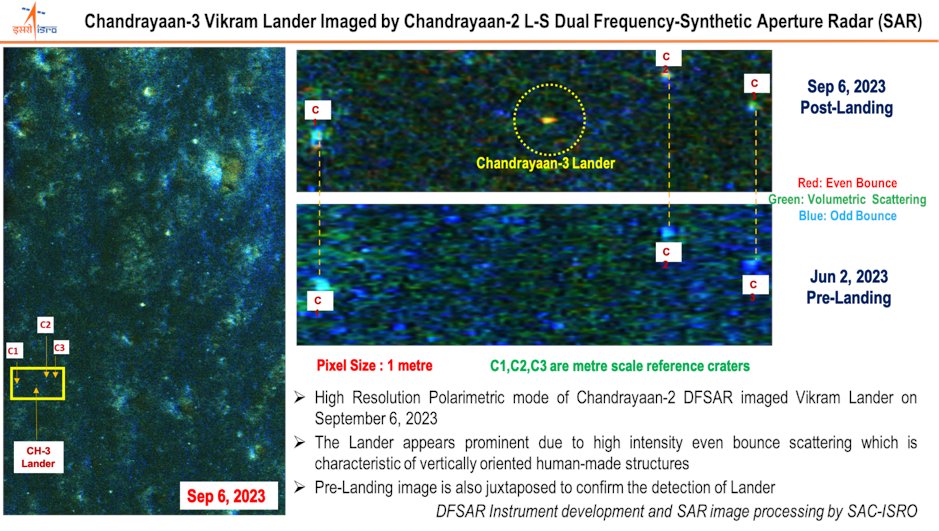Latest Updates
Chandrayaan-3: Chandrayaan-2’s orbiter sends images of the Vikram Lander ‘sleeping’ on the moon

The sleeping Vikram Lander of Chandrayaan-3 was pictured by the Chandrayaan-2 orbiter on Saturday parked on the Southern Pole of the moon. India’s lunar mission Chandrayaan-3 has successfully transmitted vital information and images back to the Earth and has entered sleep mode on Monday awaiting the next sunrise on the moon to resume its experiments. It takes 14 Earth days for the moon to complete one full rotation and for one lunar day to pass.
Taking to X, ISRO shared the image of the Vikram Lander captured by the Chandrayaan-2 orbiter. “Chandrayaan-3 Mission: Here is an image of the Chandrayaan-3 Lander taken by the Dual-frequency Synthetic Aperture Radar (DFSAR) instrument onboard the Chandrayaan-2 Orbiter on September 6, 2023,” Tweeted ISRO. The image of the lander was captured using the Dual-frequency Synthetic Aperture Radar (DFSAR) instrument of the Chandrayaan 2 Orbiter on Wednesday.
Chandrayaan-3 Mission:
— ISRO (@isro) September 9, 2023
Here is an image of the Chandrayaan-3 Lander taken by the Dual-frequency Synthetic Aperture Radar (DFSAR) instrument onboard the Chandrayaan-2 Orbiter on September 6, 2023.
More about the instrument: https://t.co/TrQU5V6NOqpic.twitter.com/ofMjCYQeso
"DFSAR state-of-the-art instrument provides the highest resolution polarimetric images currently available in any planetary mission”, said ISRO. The DSFAR is a radar-based system that can capture high-resolution images even without the presence of sunlight. The orbiter employs a SAR instrument that transmits microwaves within the L- and S-band frequencies and receives the reflected signals from the surface.
Much like Chandrayaan-3, the lunar mission Chandrayaan-2 was also supposed to successfully touch down upon the lunar surface. However, it crashed during its landing attempt. The orbiter remains functional and has played a crucial role during the landing of Chandrayaan-3.
The Chandrayaan-3 successfully soft landed on the lunar surface on August 23, making India the first country to reach the Southern pole of the moon, and the fourth country to undertake such a lunar mission. The Vikram lander detected the presence of sulfur on the moon, in addition to re-routing itself to avoid craters. It entered a sleep mode on Monday and the ISRO scientists are hopeful that the Lander will survive the harsh cold conditions and will be operational once again when the sun rises on the moon.






.webp)
.webp)

